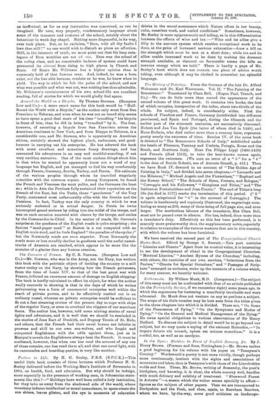The History of Painting. From the German of the late
Dr. Alfred Woltmann and Dr. Karl Woermann. Vol. IL "The Painting of the Renascence." Translated by Clara Bell. (Kogan Paul, Trench, and Co.)—We can do little more than record the appearance of the second volume of this great work. It contains two books, the first of which occupies, irrespective of the index, about two-thirds of the whole. Its subject, indeed, is considerably wider. First the schools of Flanders and France, Germany (subdivided into different provinces), and Spain and Portugal, during the fifteenth and the earlier part of the sixteenth centuries, are successively discussed. Hubert and Jan Van Eyck (the latter of whom died in 1440), and Hans Holbein, who died rather more than a century later, represent pretty nearly the extremes of time. Section IV. of the same book is devoted to "The Renascence Schools of Italy," subdivided under the heads of Florence, Tuscany and Umbria, Perugia, Rome and the South, and Northern Italy. Here Fra Filippo Lippi (1406-1469) and Francia (died 1513), to take the best-known names again, represent the extremes. (We note an error of a " 5" for a "4" in the date of Ercole Roberti, son of Antonio Grand', p. 412.) Then we have Book IV. devoted to an account of "The Golden Age of Painting in Italy," and divided into seven chapters,—" Leonardo and the Milanese," "Michael Angelo and the Florentines," "Raphael and the Roman School," "The Schools of Siena, Ferrara, and Bologna," " Correggio and his Followers," " Giorgione and Titian," and " The Italians at Fontainebleau and Jean Cousin." The end of Titian's long life (he died in 1577) marks the termination of this period. (" 5" is again misprinted for "4" in the account of Correggio.) The volume is handsomely and copiously illustrated, the engravings num- bering as many as 290, many of them being of full-page size, and even larger. The meritorious labours of the translator, Mrs. Clara Bell, must not be passed over in silence. She has, indeed, done more than a translator's duty. Effectively as this has been performed, it is scarcely more praiseworthy than the supplementary notes, especially in relation to examples of the various masters that are in this country, with which the volume has been furnished.


















































 Previous page
Previous page